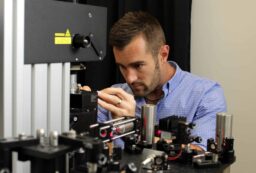Hunting molecules that signal pain
Researchers close in on an objective measure for physical distress.

A new microscope-based method for detecting a particular molecule in the spinal cord could help lead to an accurate and independent universal pain scale, research from Australia’s Macquarie University suggests.
An accurate way of measuring pain is of critical importance because at present degrees of discomfort are generally assessed by asking a patient to estimate pain on a one-to-10 scale. The situation is even more acute in the treatment of babies, the very old and animals, where speech is absent.
Now, researchers led by Dr Lindsay Parker may have come up with a solution.
“Even though pain can feel widespread in our bodies, the molecules that actually make us feel it are hard to find and quantify,” she says.
“By using a fluorescent chemical that has unique properties and a microscope adapted to see this chemical in the dimension of time instead of colour, we were able to see genes involved in chronic pain-related inflammation with a much greater sensitivity than the ways we normally see molecules on a regular microscope.”
These findings will help researchers identify hard-to-find molecules that correlate to levels of pain, providing for the first time a measure that does not depend on self-reporting or a clinician’s best guess.
Dr Parker and her colleagues – which include researchers from the University of Adelaide – hope that their work will lead to the development of the world’s first simple lab-based test for determining levels of pain.
The most recent research is published in the Journal of Neuroinflammation.
Feature photo credit: Jim De Ramos





 Fresh Science is on hold for 2022. We will be back in 2023.
Fresh Science is on hold for 2022. We will be back in 2023.